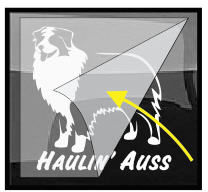Vinyl Decal ~ choose size
This decal does not have color options. It comes in white vinyl only with the dog's vest printed on the vinyl as shown.
NickerStickers Decals are Easy to Apply!Whether you've never, ever applied a decal before or are an old pro, NickerStickers go on smooth and easy and stick very well.
Before you start, WASH THE SURFACE!Don't Use Window Cleaner! We recommend you use plain old soap and water, 1/3 cup soap to 1 cup water. If there is any wax build up, use a scrubby. Finish with a lint free cloth to dry. You can add additional touch of extra cleaning with rubbing alcohol, mixed half and half with water. But soap and water is usually good enough.
Step 1. Peel the transfer tape with the decal stuck to it away from the waxy backing paper. The adhesive side of your decal is now exposed. Be careful! Don't get it dirty and don't touch it with your fingers. Use the clear transfer tape to hold because you'll be taking that off later anyway. 
Step 2. Using the transfer tape, roll your decal on to the surface to which you are applying, starting at one corner and laying it down. Once it is on the surface, rub on top of the clear transfer tape and decal using a credit card and working from the center out. Press lightly at first, then repeat more firmly. Repeat several times. 
Step 3. REMOVE THE TRANSFER TAPE. The decal is under the transfer tape. Pull the transfer tape up at a sharp angle beginning at one corner. Remove the clear tape on top of the decal and throw it away. Your decal should easily stick to the surface while you are pulling up the transfer tape. If it's not sticking solid, try leaving it on overnight and taking it off the next day. 
For more information on decal application, including applying large decals,
video instruction, and trouble shooting, click here:

The Greyhound is a very old European bred sighthound, although they are reputed to be connected to Ancient Egypt and are the only dog mentioned by name in the Bible. The were historically bred for coursing game and latterly Greyhound racing. Since the rise in large scale adoption of retired racing Greyhounds, particularly in North America from the end of the 20th century, it has seen a resurgence in popularity as a family pet.
The original primary use of Greyhounds, both in the British Isles and on the Continent of Europe, was in the coursing of deer. Later, they specialized in competition hare coursing. Some Greyhounds today are still used for coursing, although artificial lure sports like lure coursing and racing are far more common and popular. During the 1920s, modern Greyhound racing was introduced into the United States, England and Ireland.
The Greyhound's combination of long, powerful legs, deep chest, flexible spine and slim build allows it to reach a full speed of 43 mph (70 kph) within just six strides from a start. There are few mammals that can accelerate so fast over a short distance. The Greyhound's speed is in part due to their extremely flexible spine and a "Double suspension rotary gallop" which describes the fastest running gait of the Greyhound in which all four feet are free from the ground in two phases, contracted and extended, during each full stride. Greyhounds also have higher levels of red blood cells than other breeds. Since red blood cells carry oxygen to the muscles, this higher level allows the hound to move larger quantities of oxygen faster from the lungs to the muscles.
Greyhounds are an intelligent breed who are quiet, gentle, and loyal to owners. They are very loving creatures, and they enjoy the company of their humans and other dogs. Whether a Greyhound enjoys the company of other small animals or cats depends on the individual dog's personality. Greyhounds will typically chase small animals, but those lacking a high 'prey drive' will be able to coexist happily with toy dog breeds and/or cats. Greyhounds are generally not barkers, which is beneficial in urban and suburban environments, and they are usually as friendly to strangers as they are with their own family.
A very common misconception regarding Greyhounds is that they are hyperactive. In retired racing Greyhounds, this is usually not the case. Greyhounds can live comfortably as apartment dogs, as they do not require much space and sleep close to 18 hours per day. In fact, due to their calm temperament, Greyhounds can make better "apartment dogs" than smaller, more active breeds. Many owners describe their Greyhounds as "45 mile per hour couch potatoes". However, a good run at least once a week is important, especially for younger greyhounds. Due to the Greyhound's prey drive and speed, it's recommended that they only be let off leash in an enclosed area. Due to their size and strength, adoption groups recommend that fences be between 4 and 6 feet, to prevent them from jumping out.
Greyhounds are typically a healthy and long-lived breed, and hereditary illness is rare. The Greyhound is thin skinned and because of their lean physique, sleeping on a hard surface can result in skin sores. Proper bedding for the Greyhound's long naps is important. They often are sensitive to insecticides, including flea collars and flea sprays. Greyhounds occasionally develop separation anxiety when re-housed or when their owners have to leave them alone for a period of time. The addition of a second Greyhound often solves this problem. The Greyhound lacks an undercoat, which makes them less likely to trigger allergic reactions in people, but also provides no protection against severe weather. Greyhounds need to live inside in cold climates.
|